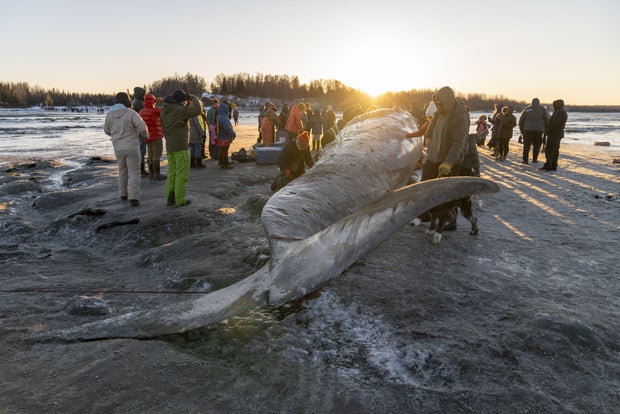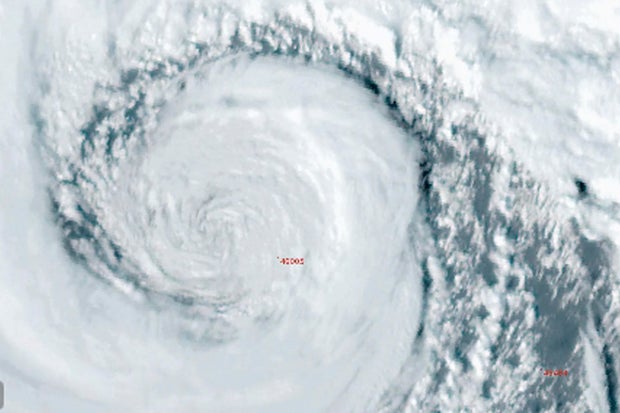CBS News
Endangered fin whale measuring nearly 50 feet found dead near Anchorage, drawing curious onlookers to beach

An endangered fin whale that washed up near a coastal trail in Alaska’s largest city has attracted curious onlookers while biologists seek answers as to what caused the animal’s death.
The carcass found over the weekend near Anchorage was 47 feet (14.3 meters) long – comparable to the width of a college basketball court – and female, according to National Oceanic and Atmospheric Administration biologists.
Barbara Mahoney, a NOAA biologist examining the whale, told the Anchorage Daily News the whale was likely 1 to 3 years old.
Fin whales are the second-largest whale species, according to NOAA Fisheries, and fully grown can reach up to 85 feet long and weigh between 40 tons and 80 tons. Strikes by ships, entanglements in fishing gear, underwater noise and the effects of climate change are among the threats that fin whales face, according to the agency.
Hasan Akbas/Anadolu via Getty Images
Mandy Keogh, a NOAA marine mammal stranding coordinator, said fin whales generally aren’t seen this close to Anchorage and that recent high tides may have pushed the animal further into the Knik Arm.
People trekked across the mudflats to see the whale, which NOAA biologists and staff from Alaska Veterinary Pathology Services had anchored to the shore Sunday so they would be able to gather samples from the animal. But even after samples are analyzed, it can be difficult to determine a cause of death because of decomposition or a lack of obvious injuries, Keogh said.
Daisy Grandlinard was among the parents who accompanied a group of children to see the whale Monday. As they drew closer, they could smell it, she said.
“It was really interesting for the kids to be able to feel it, touch the bottom because it kind of had tracks on it, like a sled almost. And just to see the size of it, that was pretty cool,” she said. “We had already studied whales a couple of weeks ago, so it was fun to see one in person and say, ‘Oh, that’s what the baleen looks like in real life,’ and ‘Where is the blow hole?’ “
Biologists hoped to complete their work Tuesday, untether the carcass and “let the tide push it or move it,” Mahoney said. “Whatever it does or doesn’t do – we don’t know.”
According to NOAA, the whaling industry killed nearly 725,000 fin whales in the mid-1900’s in the Southern Hemisphere alone. Today, the major threat to the species comes from vessel strikes.
Other fin whales have washed ashore along the Western U.S. this year. In August, a large fin whale washed ashore in Southern California and died before rescuers could get to the scene, CBS Los Angeles reported. Officials said the whale, which was not fully grown, was believed to be in poor health due to visible bumps on its skin and a thin build.
In February, a 46-foot-long whale was found washed up on an Oregon shore — emaciated, entangled and covered in what appears to be wounds from killer whales.
CBS News
House Ethics Committee meeting amid pressure over Gaetz report, Trump standing by his AG pick

Watch CBS News
Be the first to know
Get browser notifications for breaking news, live events, and exclusive reporting.
CBS News
Bomb cyclone in Northwest leaves hundreds of thousands without power, kills at least 1

A major storm swept across the northwestern U.S., battering the region with strong winds and rain, causing widespread power outages and downing trees that killed at least one person.
The Weather Prediction Center issued excessive rainfall risks through Friday and hurricane-force wind warnings were in effect as the strongest atmospheric river – a large plume of moisture – that California and the Pacific Northwest have seen this season overwhelmed the region. The storm system that started hitting Tuesday is considered a bomb cyclone, which occurs when a cyclone intensifies rapidly.
National Weather Service Portland via AP
Falling trees struck homes and littered roads across northwest Washington. In Lynnwood, Washington, a woman died Tuesday night when a large tree fell on a homeless encampment, South County Fire said in a statement on X. In Seattle, a tree fell onto a vehicle, temporarily trapping someone inside, the Seattle Fire Department reported. The agency later said the person was in stable condition.
“Trees are coming down all over the city & falling onto homes,” the fire department in Bellevue, about 10 miles east of Seattle, posted on the social platform X. “If you can, go to the lowest floor and stay away from windows. Do not go outside if you can avoid it.”
Eastside Fire & Rescue via AP
Early Wednesday, over 600,000 houses in Washington state were reported to be without power on PowerOutage.us. The number of outage reports had fluctuated wildly Tuesday evening, likely due in part to several weather and utility agencies struggling to report information on the storm because of internet outages and other technical problems. It wasn’t clear if that figure was accurate. More than 4,000 had lost power in Oregon and nearly 15,000 in California.
As of 8 p.m., the peak wind speed was in Canadian waters, where gusts of 101 mph were reported off the coast of Vancouver Island, according to the National Weather Service in Seattle. Along the Oregon coast, there were wind gusts as high at 79 mph Tuesday evening, according to the National Weather Service in Medford, Oregon, while a wind speed of 77 mph was recorded at Mount Rainier in Washington.
The National Weather Service warned people on the West Coast about the danger of trees during high winds, posting on X, “Stay safe by avoiding exterior rooms and windows and by using caution when driving.”
In Northern California, flood and high wind watches were in effect, with up to 8 inches of rain predicted for parts of the San Francisco Bay Area, North Coast and Sacramento Valley. Twelve-16 inches were forecast for far Northern California and far southwestern Oregon into Friday, according to the National Weather Service Weather Prediction Center. Dangerous flash flooding, rock slides and debris flows were expected.
A winter storm watch was issued for the northern Sierra Nevada above 3,500 feet, where 15 inches of snow was possible over two days. Wind gusts could top 75 mph in mountain areas, forecasters said.
The National Weather Service issued a flood watch for parts of southwestern Oregon through Friday evening, while rough winds and seas halted a ferry route in northwestern Washington between Port Townsend and Coupeville.
A blizzard warning was issued for the majority of the Cascades in Washington, including Mount Rainier National Park with up to a foot of snow and wind gusts up to 60 mph, according to the weather service in Seattle. Travel across passes could be difficult if not impossible.
The Weather Prediction Center said heavy, wet snow would fall along the Cascades and far Northern California. accumulating at rates of two-three inches per hour. That along with gust sup to 65 mph could result in whiteout/blizzard conditions and “near impossible travel at pass level,” the center said.
CBS News
Woman linked to 14 cyanide murders is convicted and sentenced to death in Thailand

A Thai woman believed to be among the worst serial killers in the kingdom’s history was convicted and sentenced to death Wednesday for poisoning a friend with cyanide, in the first of her 14 murder trials.
Sararat Rangsiwuthaporn, 36, an online gambling addict, is accused of swindling thousands of dollars from her victims before killing them with the chemical.
A court in Bangkok convicted her Wednesday for fatally poisoning her friend Siriporn Kanwong.
The two met up near Bangkok in April last year to release fish into the Mae Klong river as part of a Buddhist ritual.
Siriporn collapsed and died shortly afterwards and investigators found traces of cyanide in her body. Last year, police said they collected fingerprints and other evidence from Sararat’s Toyota Forerunner.
LILLIAN SUWANRUMPHA/AFP via Getty Images
Police were then able to link Sararat to previously unsolved cyanide poisonings going back as far as 2015, officers said.
“The court’s decision is just,” Siriporn’s mother, Tongpin Kiatchanasiri, told reporters following the verdict. “I want to tell my daughter that I miss her deeply, and justice has been done for her today.”
Police said Sararat funded her gambling addiction by borrowing money from her victims — in one case as much as 300,000 baht (nearly $9,000) — before killing them and stealing their jewelry and mobile phones.
She lured 15 people — one of whom survived — to take poisoned “herb capsules,” they said.
Sararat faces 13 more separate murder trials, and has been charged with around 80 offenses in total.
Her ex-husband, Vitoon Rangsiwuthaporn — a police lieutenant-colonel — was given 16 months in prison and her former lawyer two years for complicity in Siriporn’s killing, the lawyer for the victim’s family said.
The couple, while divorced, had still been living together, the BBC reported. Police said Rangsiwuthaporn was likely involved in Sararat’s alleged murder of an ex-boyfriend, Suthisak Poonkwan, the BBC reported. Police said that after she killed him, Rangsiwuthaporn picked her up in her car and helped her extorte money from Suthisak’s friends.
Thailand has been the scene of several sordid and high-profile criminal cases.
Earlier this year, six foreigners were found dead in a luxury Bangkok hotel after a cyanide poisoning believed to be connected to debts worth millions of baht.











